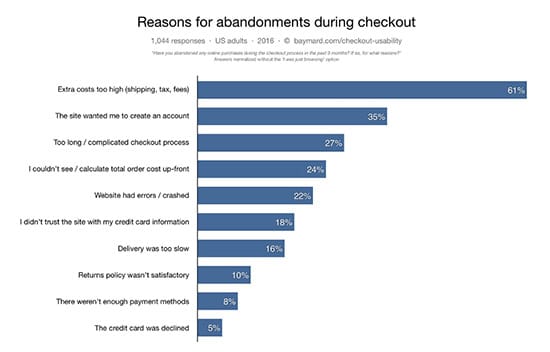How to Reduce Your Online Shopping Cart Abandonment
If online shopping was the same as real-world shopping then everything would be straightforward for online retailers. Imagine a typical customer in a brick and mortar store. They would walk into the store, start filling their shopping carts, then upon reaching the point of sales station, they are distracted by a phone call.
All of a sudden they forget what they were to buy and head off to do other things. Admittedly, this is almost unlikely to happen. But this is the situation in the online shopping world.
Why should the shopping cart abandonment be a concern to you?
One of the biggest obstacles that e-commerce retailers have to overcome is shopping cart abandonment. According to Baymard, almost 70% of online shoppers exit without making a purchase. For any serious retailer, this is a massive revenue opportunity. This means online retailers should learn how to optimize their shopping experience to transform the abandoned carts to sales.
The research shows that the average rate of ecommerce shopping cart abandonment could be even higher than the above percentage. In 2017, 78% of online shoppers left a site without buying anything. Basically, three in every four shoppers who visit e-commerce stores will leave before crossing the line and paying.

The broken down of the top reasons why shoppers leave the carts. © Baymard Institute
In fact, Baymard Institute has broken down the top reasons why these shoppers abandon their shopping carts. The top reasons being exorbitant shipping costs (61%), didn’t want to create an account (35%), and the lengthy checkout process (27%).
Even though the above metrics show how bleak things are for e-commerce retailers, it would be more meaningful if marketers adjust how they treat cart abandonment. The data and analytics can only tell them so much, so they have to understand why do customers abandon online shopping carts. Below are the ways to reduce online shopping cart abandonment.
1. Be upfront about shipping costs and provide express shipping
A majority of customers will leave without buying from your site because of hidden costs. High shipping cost, specifically, has been cited as the deal breaker. According to data from Forrester, 44% of online shoppers are ready to abandon their carts due to high shipping costs. In the same study, 22% of online shoppers abandoned ecommerce shopping cart because the e-commerce retailer failed to mention the shipping costs.
In a similar study conducted by E-tailing Group (PDF), a majority of online shoppers mentioned that they are more likely to buy from an online store if they provide unconditional free shipping. Besides the high shipping cost, you should also pay heed to any other hidden costs such as required complementary items or taxes. Most shoppers will not only trigger immediate annoyance, but they might also propel shoppers to feel remorse for buying from you.
2. Simplify the checkout process
As alluded in early, a lengthy checkout process can cause ecommerce cart abandonment. So, if you have multi-page checkout, you should not ask for additional details through questions, forms, or presenting more products at each point. All these things will prolong the checkout process. Some customers may feel irritated along the way.
There could be situations where the above additions are necessary. In such a case, you can have an “Express Checkout” option where customers, while viewing their carts, can opt to complete the purchase. Another way to improve the process is to include a progress indicator on each checkout page. When you provide shoppers with a way to know where they are in the shopping process, you are eliminating the chance of worrying that it may take more time to buy from you than they had planned.
In the real world, customers rarely shop in a single streamlined manner. In most cases, they are inefficient, indirect, and nonlinear. So, if you make it easy for them to navigate between the shopping cart and the store, you will have improved their shopping experience. Reducing the friction between the cart and store could be one of the hardest things to achieve but with experimentation, you can optimize each time.
3. Improve trust in the buying process
Unlike real store customers, online customers have to put a lot of trust in an online retailer when they are shopping. There are many risks that they are exposing themselves to, for instance, giving out their financial information. The simplest way to build trust is to show shoppers that their personal information is secure, such as including security details in your transaction form. Some retailers may treat forms as a mere formality in the transaction process.
The screenshot of security logos people always see on website. © Actualinsights
One of the studies by Actual Insights shows that 61% of shoppers will not complete a purchase if the security logos are missing. So, to avoid the hesitation of giving you their financial information and their hard-earn cash, you should use your transaction forms as a way of building trust. Utilize trust symbols from well-respected partners such as Norton, Verified, PayPal, or Verisign. The same study from Actual Insights indicates that 75% of customers did not buy from an online retailer because they did not recognise the trust signals used.
4. Improve on page load times and website errors
The studies shows ecommerce cart abandonment can increase by 7% for every one-second delay. The situation can be even worse if your site crashes. The online audience, in general, tends to be impatient, so if it takes time to find what they need from your site, they will look elsewhere.
One of the technical elements that you need to pay attention to your store is web hosting. If you started with a simple hosting plan, then you should scale up to VPS or dedicated hosting when your site keeps growing bigger. You should also optimize your images in a way that maintain a balance between the speed and quality.
Make an effort to go through your site on a regular basis to ensure that there is no issue and web hosting is up to date. Website crashes, errors, and poor load times are some of the major deterrents to buying from an e-commerce store.
5. Facilitate for future purchase and follow up on abandoned sales
For an e-commerce marketer, the easiest way of reducing shopping cart abandonment is to look for ways of remarketing to the shoppers at a later date. These are people who came cross to closing the line, so you are almost sure that they were interested in the product.
One of the best channels to remarket to your customers is through social media such as Facebook ads. If you capture their email address during the shopping process, set up an autoresponder series immediately they leave their cart. Another creative strategy is to offer a way for them to make a wish list so that they can purchase the items at a later date.
Conclusion
While ecommerce cart abandonment is inevitable, you can reduce the number of online shoppers who exit your site without making a purchase. The purpose of this guide was to help you understand some of the reasons why your customers are leaving your store. This is the first step in improving your conversion rates. In any case, there is a huge opportunity that remains untapped.







No responses yet to “How to Reduce Your Online Shopping Cart Abandonment”